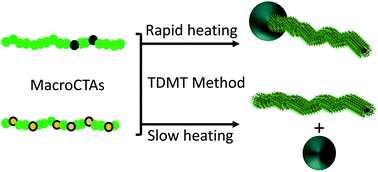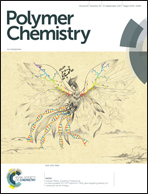Conditions for multicompartment polymeric tadpoles via temperature directed self-assembly†
Abstract
The temperature-directed morphology transformation (TDMT) method is a powerful technique to produce nanostructures directly in water at scale. The TDMT method can also be used to form the asymmetric tadpole nanostructure, in which the head chemical functionality can be different and orthogonal to the functionality on the tail. The aim of this work was to determine the conditions and therefore the criteria for tadpole formation. It was found that rapid heating of all components (i.e. two macro-chain transfer agents (MacroCTAs), monomer, initiator, surfactant and water) from ∼3 to 70 °C produced narrow molecular weight diblock copolymers and a narrow latex particle distribution with a size close to 100 nm. When the polymerization mixture was then cooled to a temperature between the two MacroCTAs, well-defined tadpole structures were produced. Other methods, for example, slow heating or post-addition of monomer and initiator at 70 °C, did not produce tadpoles due to either a broad particle size distribution or a broad molecular weight distribution.



 Please wait while we load your content...
Please wait while we load your content...